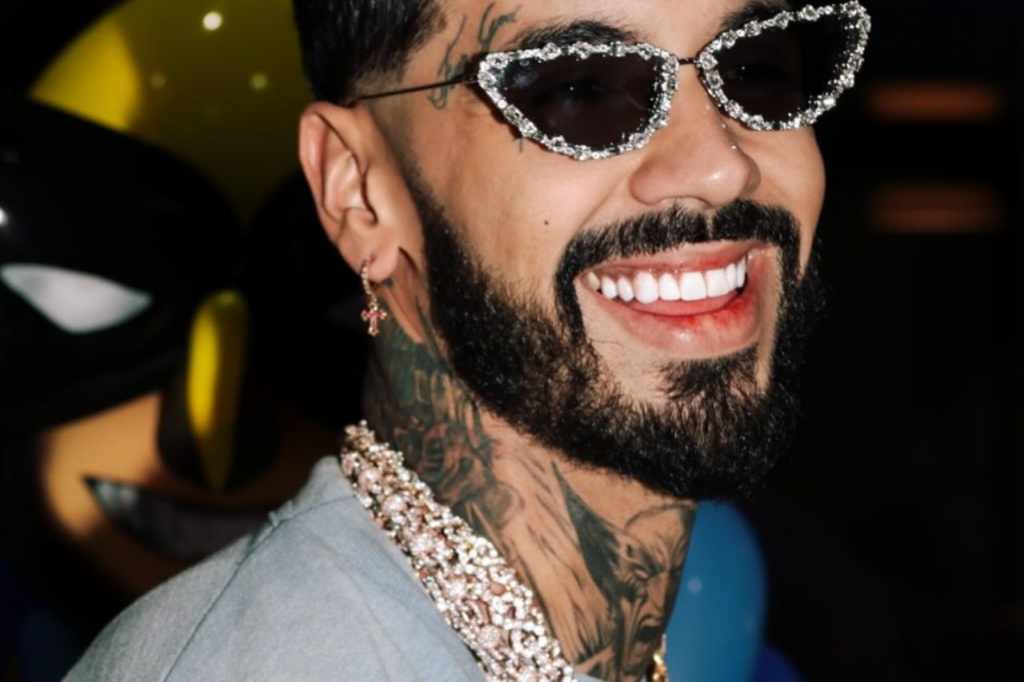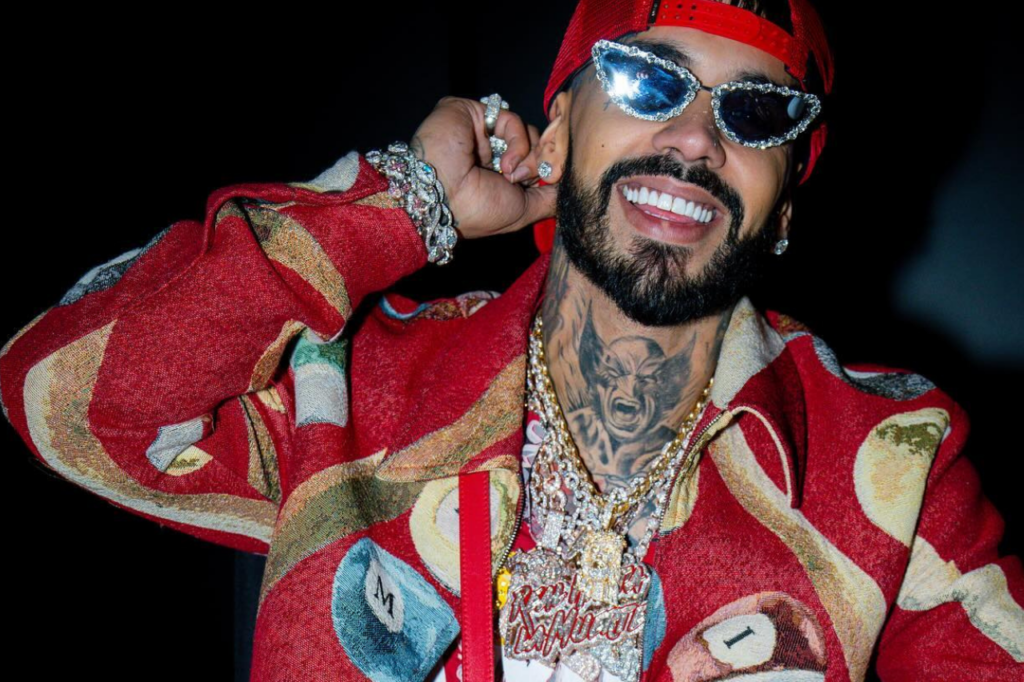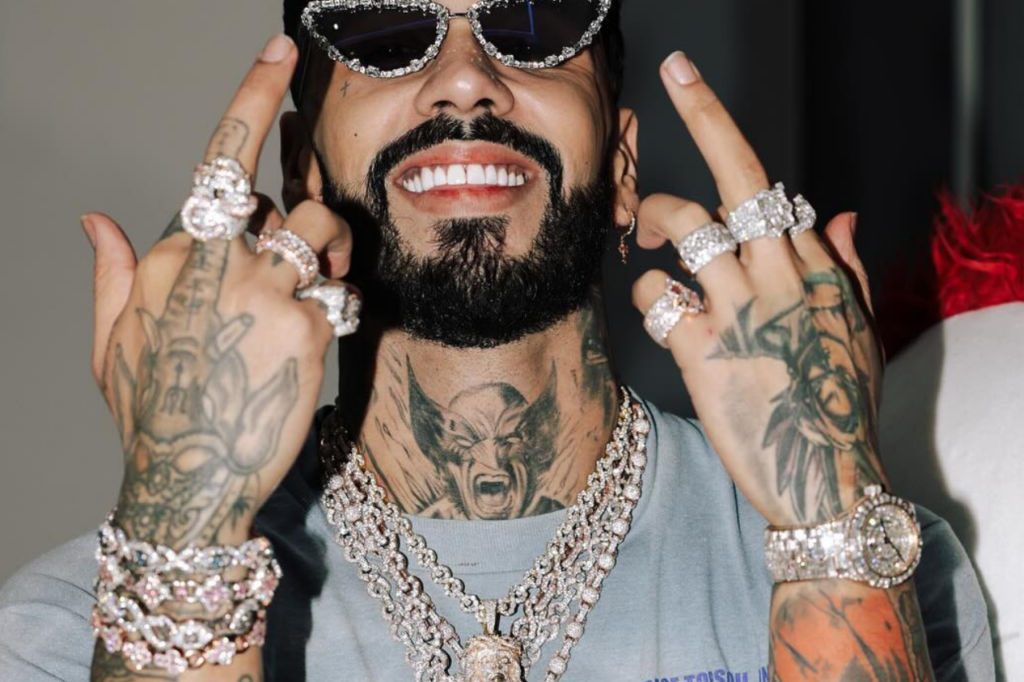In the mid-2010s, when Latin music was still finding its footing in the global mainstream, Anuel AA recognized a crucial gap in the market that others had overlooked. While English-language trap music dominated global charts through artists like Lil Wayne and Drake, Spanish-language music remained largely confined to traditional genres. The innovation wasn’t simply in translating trap music into Spanish—it was in fundamentally reimagining how the Spanish language could flow within trap’s distinctive rhythmic framework.
“Nobody in the Spanish Community used to do trap music or hip-hop or R&B, nobody,”
Anuel recalls in the interview, highlighting the vastness of the untapped opportunity before him. His approach was methodical, almost scientific in its precision. Rather than merely emulating English-language trap, he undertook a comprehensive study of the genre’s evolution, diving deep into the catalogs of artists from The Beatles to Tupac, analyzing their techniques and adapting them for Spanish-language delivery.

The technical challenges were significant. Spanish, with its rolling ‘r’s and melodic intonations, doesn’t naturally conform to trap music’s staccato rhythms and syncopated patterns. Anuel describes this as learning to “skate in the beat”—a process of developing a new flow that would allow Spanish lyrics to glide naturally over trap instrumentals. This required breaking free from the conventional pronunciation patterns of Spanish, creating a more fluid, street-influenced delivery that would become a blueprint for future artists.
His innovative approach extended beyond mere technical execution. Anuel understood that authentic trap music required more than just linguistic adaptation—it needed cultural resonance. Drawing from his own experiences in Carolina’s streets, he infused his lyrics with raw, unfiltered narratives that reflected the realities of Puerto Rican street life, creating a bridge between American trap’s storytelling traditions and Latin American urban experiences.
The result was transformative. What began as an experiment in genre-blending evolved into a cultural movement that would reshape the Latin music landscape. “Now you put a hip-hop music in English or Spanish and it sound the same way but with different language,” Anuel notes, highlighting how complete the integration has become. This achievement is particularly remarkable considering the initial skepticism he faced, even from industry veterans who questioned the viability of Spanish-language trap.
Through this pioneering work, Anuel didn’t just create a new sound—he established a framework that would enable an entire generation of Latin artists to explore and expand upon the genre. His success demonstrated that language barriers in music could be overcome not through imitation, but through innovation and cultural authenticity. The blueprint he created has since become a foundation for Latin trap’s global ascendance, proving that sometimes the most significant musical innovations come not from following established paths, but from daring to create entirely new ones.

The story of Anuel AA begins at an unlikely intersection of privilege and hardship, weaving a tale that would ultimately shape Latin music’s future. As the youngest of four children born to José Gazmey, a former vice president of Sony Music’s Puerto Rico division, Anuel’s early years were steeped in the melodies and rhythms of Latin music’s golden era. His father’s position as an A&R executive and later vice president at Sony Music placed young Anuel in the orbit of Latin music legends, with his household becoming a crossroads of artistic influence and industry expertise.
The family’s story took a dramatic turn when Anuel was around eight years old. His father’s departure from Sony Music marked the beginning of a series of financial setbacks that would reshape their lives. Failed investments and mounting financial pressures transformed their reality from one of comfort to uncertainty. This transition wasn’t merely financial—it marked a profound shift in Anuel’s worldview and would later influence his authentic approach to music.
One of the most poignant moments from this period, as Anuel recalls, was witnessing his mother in tears as bank representatives arrived at their home. The family faced the very real prospect of losing their house and relocating from their private community to public housing. This moment stands as a crucial turning point in Anuel’s narrative, marking the beginning of his gradual drift toward street life.
Yet amid this downturn, a seed of future success remained. His father, having acquired a modest recording setup during more prosperous times, had inadvertently provided the foundation for Anuel’s musical journey. This basic studio equipment, coupled with his father’s industry knowledge, became the launching pad for Anuel’s earliest musical experiments. More significantly, his father took the time to teach him the fundamentals of recording, though notably without pushing him toward a music career.
This intersection of circumstances—the early exposure to music industry excellence through his father’s work, the harsh reality of financial hardship, and access to basic recording equipment—created a unique alchemy. While his brothers maintained their trajectory, Anuel, as the youngest, found himself increasingly drawn to the streets of Carolina, particularly through friendships with those living in nearby public housing projects. By age 10 to 12, he was regularly immersing himself in street culture, driven by a desire to help his family financially while simultaneously developing his musical craft.
This period of Anuel’s life demonstrates how privilege and hardship can coexist and shape an artist’s perspective. His understanding of both worlds—the polished music industry through his father’s legacy and the raw reality of street life—would later enable him to create music that resonated across social boundaries, speaking authentically to both experiences. The basic recording equipment left from his family’s more prosperous days became not just a tool for making music, but a bridge between these two worlds, allowing him to channel his experiences into what would eventually become a revolutionary new sound in Latin music.

In the landscape of modern music, innovation often emerges from the intersection of cultural necessity and artistic vision. For Anuel AA, the creation of Spanish trap music wasn’t merely about translation—it was about transformation. At a time when English-language trap music dominated global charts through artists like Lil Wayne and Drake, the Spanish music market remained largely untouched by this revolutionary sound.
“Nobody in the Spanish Community used to do trap music or hip-hop or R&B, nobody,”
His approach to creating this new genre was methodical and deeply analytical. Rather than simply attempting to recreate English trap music with Spanish lyrics, Anuel undertook a comprehensive study of the genre’s evolution. He delved deep into the catalogs of influential artists, starting with contemporary figures like Lil Wayne and Rick Ross, but also reaching back to study The Beatles, Tupac, and other foundational musicians. This archaeological approach to music allowed him to understand not just the surface elements of trap music, but its underlying structural principles.
The technical challenges were formidable. Spanish, with its distinctive rhythmic patterns and phonetic structure, doesn’t naturally align with trap music’s characteristic flow. Anuel describes this challenge through the metaphor of “skating on the beat”—a vivid description of how he developed a new approach to timing and delivery that would allow Spanish lyrics to glide naturally over trap instrumentals. This required breaking free from traditional Spanish pronunciation patterns, creating a more fluid, street-influenced delivery that would become the blueprint for future artists.
What set Anuel’s approach apart was his understanding that authentic trap music required more than technical proficiency—it needed cultural resonance. He observed how English-language trap artists drew from their lived experiences, and he applied this principle to his own work, infusing his lyrics with raw narratives from Puerto Rican street life. This cultural authenticity helped bridge the gap between American trap’s storytelling traditions and Latin American urban experiences.

The evolution was gradual but deliberate. Anuel began by creating Spanish versions of popular English trap songs, using these adaptations as a laboratory to perfect his technique. Songs like Young Thug’s “Check” became testing grounds for developing new flows and rhythmic patterns that would work in Spanish. These experiments helped him understand how to maintain the essential energy and attitude of trap music while adapting it to Spanish language’s natural cadences.
Perhaps most significantly, Anuel’s innovation extended beyond his own music. By solving the technical challenges of creating Spanish trap, he established a framework that would enable an entire generation of Latin artists to explore and expand upon the genre. “Nowadays you put a hip-hop music in English or Spanish and it sound the same way but with different language,” he notes, highlighting how complete the integration has become.
This blueprint has proven so successful that it has helped reshape the global music landscape. What began as an experiment in genre-blending has evolved into a cultural movement that has elevated Latin music to unprecedented levels of global recognition. Modern Latin trap artists routinely appear on global charts alongside their English-speaking counterparts, a testament to how thoroughly Anuel’s innovations have transformed the musical landscape.
In the annals of music history, few artists have transformed incarceration into a catalyst for unprecedented success quite like Anuel AA. His 30-month sentence for firearm possession, beginning in 2016, could have marked the end of a promising career. Instead, it became the crucible from which one of Latin music’s most compelling success stories would emerge.
When Anuel entered prison, he carried with him something more valuable than his 200,000 Instagram followers—he had a strategic vision for maintaining and building his presence despite physical confinement. The numbers tell a striking story: by the time he completed his sentence, his following had exploded to 4 million, a testament to the power of strategic thinking in the digital age.
The mechanics of recording music from behind bars required both ingenuity and careful planning. While details of the process remain deliberately vague, Anuel acknowledges recording some tracks through prison phones, a practice that carried significant risk. “When you get caught with a phone or with a fight or with knives or anything, you get sent to the box,” he explains, referring to solitary confinement. Indeed, such an incident extended his sentence when he was caught with a phone, demonstrating the high stakes of his musical pursuits.
Perhaps the most brilliant aspect of Anuel’s incarceration period was his sophisticated approach to content release. “I used to have so many songs at the beginning,” he recalls, describing how he carefully rationed his musical output. His release strategy showed remarkable foresight: when a song would gain significant traction, he would deliberately pause releases, creating anticipation while preserving his finite inventory of recorded material. “Wait this month, don’t drop this month, boom, don’t drop, don’t drop,” he describes, illustrating the calculated nature of each release decision.
This period also marked a profound evolution in his artistry. The authenticity of his experience, combined with the forced isolation of imprisonment, seemed to deepen the emotional resonance of his music. Unlike many artists who face incarceration and fade from public consciousness—a fate he explicitly wanted to avoid after witnessing others’ careers dissolve during imprisonment—Anuel managed to maintain and even enhance his artistic relevance.
The impact of this period extends beyond mere numbers or strategic success. His experience became a powerful testament to resilience and strategic thinking in the modern music industry. While previous eras might have seen prison time as a career-ending setback, Anuel’s story demonstrates how digital platforms and careful content management can transform even the most challenging circumstances into opportunities for growth.

Today, this chapter in Anuel’s career serves as both a cautionary tale and a masterclass in crisis management. His ability to grow his following twentyfold while physically removed from society represents a new paradigm in artist development—one where strategic thinking and authentic storytelling can transcend physical barriers. As he notes, “Music really saved my life,” a statement that carries particular weight given how he transformed his period of incarceration from a potential career-ender into a launchpad for global stardom.
The prison-to-prominence narrative has become an integral part of Anuel’s artistic identity, informing his music and strengthening his connection with audiences who see in his story a broader message about resilience and redemption. It stands as a testament to how modern artists can maintain and even build their relevance despite physical confinement, provided they approach their circumstances with strategy, authenticity, and unwavering dedication to their craft.
The ascendance of Latin trap from niche genre to global phenomenon represents one of the most significant shifts in contemporary music, with Anuel AA serving as a pivotal architect of this transformation. His impact extends far beyond personal success, fundamentally reshaping how Latin music is created, consumed, and celebrated on the global stage.
When examining the current state of global music charts, it’s easy to forget that Latin artists once struggled to break into mainstream rankings. As Anuel notes, “Back then you used to look at any chart, global chart, it was impossible to see a Spanish artist or Spanish song charting top 10, top 20, top 50.” The landscape has shifted dramatically, with Latin music now regularly competing alongside—and often outperforming—English-language releases. This evolution wasn’t merely organic; it required pioneering artists who could envision and execute a new paradigm for Latin music.
The industry’s institutional recognition of Latin trap has undergone a similar evolution. Initially, award shows and industry organizations struggled to categorize this emerging genre. “They didn’t even know how to award it, how to label it,” Anuel recalls, highlighting the challenges faced by early Latin trap artists. The creation of new award categories and recognition frameworks for Spanish trap music reflects not just its commercial success, but its establishment as a legitimate artistic movement.
Perhaps most significantly, Anuel’s success has helped reshape the power dynamics within the global music industry. Where Spanish-language artists once felt pressure to cross over into English markets for mainstream success, today’s Latin artists can achieve global recognition while maintaining their linguistic and cultural authenticity. This shift is evidenced by the increasing number of collaborations between English and Spanish-language artists, with Latin trap serving as a bridge between musical traditions.
The numbers tell a compelling story of market transformation. Latin music’s share of the global music market has seen unprecedented growth, with streaming platforms reporting dramatic increases in Latin music consumption across all regions. This growth isn’t limited to Spanish-speaking markets—Latin trap has found enthusiastic audiences in markets where Spanish isn’t widely spoken, demonstrating music’s power to transcend linguistic barriers.
This cultural impact extends beyond pure entertainment. Through his music and success, Anuel has helped validate the experiences and perspectives of a new generation of Latin artists and listeners. His authentic portrayal of street life and personal struggles, delivered through the innovative medium of Latin trap, has created a template for artistic expression that resonates across cultural boundaries.
Looking at the broader music industry, Anuel’s influence can be seen in the changing approach to artist development and marketing. His success has demonstrated that maintaining cultural authenticity while pursuing global appeal isn’t just possible—it’s often advantageous. This lesson has influenced how record labels and industry executives approach Latin artists, leading to more investment in Spanish-language music and greater respect for artists’ creative vision.
The ripple effects of this cultural shift continue to expand. As Anuel observes, “Now it’s really balanced,” referring to the global music landscape. This balance represents not just a commercial achievement but a cultural victory, marking the evolution of Latin music from regional phenomenon to global force. Through his pioneering work in Latin trap, Anuel AA has helped create a more diverse and inclusive global music industry, one where artistic innovation knows no linguistic or cultural bounds.
As Anuel AA stands at the intersection of his established musical success and emerging creative ventures, his trajectory offers a compelling glimpse into the evolution of a modern multi-faceted artist. With characteristic strategic vision, he’s carefully orchestrating his next chapter, one that extends beyond the boundaries of music while staying true to the authenticity that marked his rise to prominence.
The most immediate expansion of his creative portfolio lies in acting, a transition he approaches with both excitement and measured discretion. “I’m about to be in a movie,” he reveals, though maintaining strategic silence about specific details. This careful approach to his acting debut reflects the chess-player mentality he’s cultivated throughout his career—making calculated moves while maintaining an awareness of their long-term implications. The fact that his entry into acting involves working alongside established stars like Dave Bautista suggests a deliberate strategy to learn from industry veterans while leveraging his existing cultural capital.
Yet Anuel’s perspective on his legacy remains refreshingly unfinished. When discussing the possibility of a biopic about his life—a project for which he’s received multiple offers—he displays characteristic strategic patience: “I don’t think it’s not the time yet… there’s a lot of big goals still that I got on my heart.” This acknowledgment that his story is still unfolding speaks to a broader understanding of legacy as something actively shaped rather than passively received.
In the musical realm, his influence continues to expand through what he describes as “playing chess in life.” This approach manifests in his careful consideration of collaborations, timing, and artistic evolution. Unlike many artists who might rest on their laurels after achieving success, Anuel maintains a forward-looking perspective, planning six to seven months ahead while remaining responsive to current opportunities and challenges.
His impact on the next generation of Latin artists is perhaps most evident in how he’s normalized the fusion of traditional Latin music elements with contemporary global sounds. By demonstrating that Spanish-language artists can achieve international success without compromising their cultural identity, he’s created a blueprint for emerging artists to follow while encouraging them to forge their own paths.

Looking ahead, Anuel’s role in bridging English and Spanish music markets appears set to deepen. His understanding of both musical traditions, combined with his proven ability to innovate within and between them, positions him uniquely to continue facilitating cross-cultural musical exchanges. As he notes, “Nowadays it’s really balanced,” referring to the global music landscape—a balance he helped create and continues to maintain.
The legacy Anuel is building extends beyond individual achievements to encompass broader cultural transformation. His journey from pioneering Spanish trap to exploring new creative ventures demonstrates the endless possibilities when authenticity meets innovation. As he continues to expand his creative horizons, his influence on Latin music and culture seems likely to grow, shaped by the same strategic thinking and artistic vision that marked his initial rise to prominence.
In Anuel’s own words, “You got to play chess in life,” and his current moves suggest a game plan that extends far beyond the immediate future. As he balances multiple creative ventures while maintaining his musical presence, his legacy continues to evolve, promising new chapters in a story that’s already transformed Latin music’s global narrative.
The story of Anuel AA represents far more than a traditional musical success narrative—it embodies a fundamental transformation in the global music landscape. From the humble beginnings of recording on his father’s modest equipment to pioneering an entirely new genre and achieving international acclaim, his journey illuminates the power of authentic vision combined with strategic execution.
At its core, Anuel’s success stems from his ability to identify and bridge cultural gaps while maintaining unwavering authenticity. His approach to creating Spanish trap wasn’t simply about translation; it was about transformation—taking the raw energy of American trap music and reimagining it through the lens of Latin American experience. This innovation required not just musical talent but a deep understanding of both cultures and the courage to forge new pathways between them.
The impact of his work extends far beyond personal achievement. By demonstrating that Spanish-language artists can achieve global success without compromising their cultural identity, Anuel has helped reshape the power dynamics of the music industry. Where Spanish-language artists once faced pressure to cross over into English markets, today’s Latin artists can achieve international recognition while maintaining their linguistic and cultural authenticity—a shift that has profound implications for global popular culture.
His strategic approach to career development, which he often describes as “playing chess,” offers valuable lessons about long-term thinking and authentic growth in any creative field. From his careful management of content releases during incarceration to his measured expansion into acting, Anuel demonstrates how strategic patience combined with bold innovation can create lasting impact.
As he continues to evolve artistically and explore new creative ventures, Anuel AA’s legacy seems likely to grow beyond even his current considerable influence. His journey from the streets of Carolina to global stardom, marked by both triumphs and challenges, stands as a testament to the transformative power of authentic artistic vision. In bridging cultural divides while maintaining unwavering authenticity, he has not just created success for himself—he has helped reshape how global popular culture evolves in an increasingly interconnected world.
Perhaps most importantly, his story reminds us that true innovation often comes not from following established paths, but from having the courage to create entirely new ones. In doing so, Anuel AA has not just achieved personal success; he has helped create a more diverse and inclusive global music landscape, one where artistic innovation knows no linguistic or cultural bounds.


